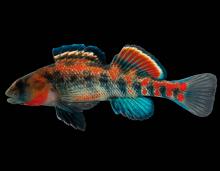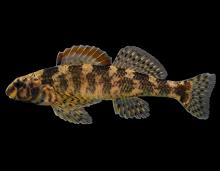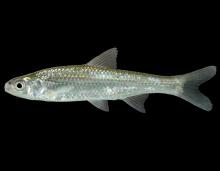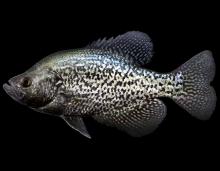Fishes
Media

Species Types
Scientific Name
Etheostoma, Percina, Ammocrypta, and Crystallaria spp.
Description
Darters have been described as the hummingbirds of the fish world: colorful, small, and quick. Missouri has about 44 different types of darters. They are most diverse in the fast, clear, rocky streams of the Ozarks.
Media

Species Types
Scientific Name
Etheostoma histrio
Description
In Missouri, the harlequin darter occurs only in our southeastern lowlands, in flowing streams and ditches with sandy bottoms. It is State Endangered because its small numbers and limited range make it vulnerable to extirpation.
Media

Species Types
Scientific Name
Umbra limi
Description
The central mudminnow is is the only mudminnow that occurs in our state, and it is rare, occurring only in a few marshy locations near the Mississippi River. Mudminnows are closely related to the pikes.
Media

Species Types
Scientific Name
Hybognathus hayi
Description
The cypress minnow, like its Bootheel swampland habitat, is in danger of vanishing from Missouri. On the forward part of this fish's side, note the distinct cross-hatched pattern made by the dark-edged scales.
Media

Species Types
Scientific Name
Anguilla rostrata
Description
The American eel is considered an uncommon catch by Missouri sport anglers. This species is known to take natural baits and rarely takes artificial baits.
Media

Species Types
Scientific Name
Dorosoma petenense
Description
The threadfin shad occurs in the Mississippi River and its tributaries. It also occurs in mainstem reservoirs of the White River Basin and in Montrose Lake and the South Grand River in Henry County.
Media

Species Types
Scientific Name
Alosa chrysochloris
Description
The skipjack herring is an active fish, moving about continuously in large schools. It probably occurs at least occasionally in most of the large rivers of the state where its migrations are not blocked by dams.
Media

Species Types
Scientific Name
Pomoxis annularis
Description
The white crappie, a popular panfish, has silver sides with 5 to 10 often faint vertical bars. The upper jaw reaches past the middle of the eye. It is more abundant and widespread than the black crappie.
Media

Species Types
Scientific Name
Pomoxis nigromaculatus
Description
The black crappie is a popular panfish. It is deep bodied and slab sided. The sides are silver with an irregular pattern of dark speckles. The upper jaw is long, reaching past the middle of the eye.
Media

Species Types
Scientific Name
Micropterus punctulatus
Description
The spotted bass inhabits permanent-flowing waters that are warmer and slightly more turbid than those where the smallmouth bass occurs. Note the form of its stripe and the length of its jaw.
See Also


Media

Species Types
Scientific Name
Amphiuma tridactylum
Description
The three-toed amphiuma is an eel-like, completely aquatic salamander. It has very small forelimbs and hind limbs, each with three tiny toes. In Missouri it’s found only in the Bootheel region.
Media

Species Types
Scientific Name
Siren intermedia nettingi
Description
The western lesser siren is an eel-like, aquatic salamander with external gills, small eyes, small forelimbs with four toes, and no hind limbs. In Missouri, it’s found mostly in the Bootheel and northward in counties near the Mississippi River.
About Fishes in Missouri
Missouri has more than 200 kinds of fish, more than are found in most neighboring states. Fishes live in water, breathe with gills, and have fins instead of legs. Most are covered with scales. Most fish in Missouri “look” like fish and could never be confused with anything else. True, lampreys and eels have snakelike bodies — but they also have fins and smooth, slimy skin, which snakes do not.





















